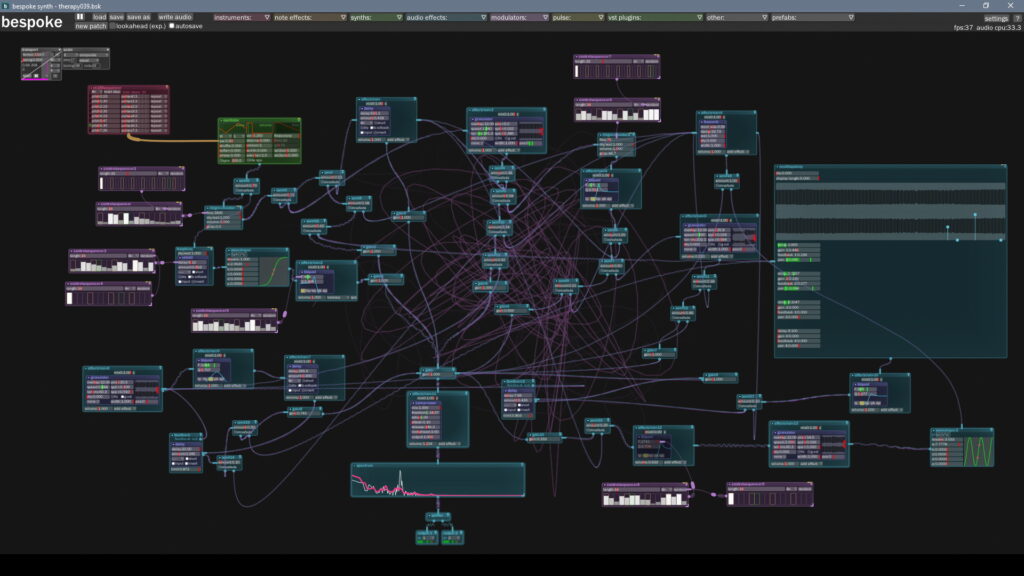Because it’s worth mentioning: while Bespoke Synth is free, they do accept donations on behalf of the NAACP. As stated on the website: “Bespoke is free, but you can pay for it if you want. All versions are identical. Your payment goes directly to the NAACP Legal Defense and Educational Fund.”
Nice. So with that bit of housekeeping taken care of, let’s get into the software itself. To quote the developer again:
Bespoke is like a DAW in some ways, but with less of a focus on a global timeline… In a way, Bespoke is like if I smashed Ableton to bits with a baseball bat, and asked you to put it back together.
Bespoke Synth is cross-platform, running on Mac OS, Windows, or Linux. Personally, I would describe it as being somewhat similar to Plogue’s modular DAW, Bidule, but with some features that seem aimed more specifically at beat-driven music. Not to imply that such a thing isn’t possible in Bidule, just that Bespoke is different in a way that seems beneficial to that approach in particular. Note that this shouldn’t be taken as me saying Bespoke can’t be used for more experimental, beatless stuff either, as that is definitely not the case. If we were to imagine a sort of “DAW spectrum,” with the very low-level modularity of something like Bidule on one end and traditional multitrack software on the other, Bespoke would be somewhere between Bidule and the more structured rack approach of something like Reason. I would say it occupies a similar space on this spectrum to the venerable AudioMulch.
What You See
Much like Bidule or a few other modular-style environments that come to mind, the main layout consists of a (mostly) blank field into which you insert modules, and then connect them via virtual wires. One of the unique, and often handy, features of Bespoke is the visualization the wires provide. Audio wires show a simple oscilloscope (waveform) display of the audio they’re carrying, with the wire itself being the scope. Control signals show up as bulges or blips in the wire carrying them, pulsing every time a signal is sent. This visual feedback is both fun and functional, and can be quite useful in troubleshooting situations.
Speaking of nifty visualizations, there is also a Lissajous scope displayed in the background by default. In addition, the Transport module plays an alternating-color animation that shows beats within a bar, as well as an angular line that gives visual feedback on the amount of swing applied (straight for no swing, gets “squiggly” with swing). All of these visual elements are a nice touch, and I can see them being especially handy for live performance, besides just being fun to watch. It should be mentioned that despite all of these visual elements, it seems pretty light on the CPU.
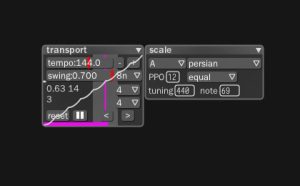
In addition to these, there are also other visualization options available as modules, such as a spectrum analyzer and the “valuestream” module that plots a control’s changes over time.
What You Get
The modules in Bespoke Synth are arranged into eight categories (plus another for external plugins): Instruments, Note Effects, Synths, Audio Effects, Modulators, Pulse, Other, and Prefabs. For the most part, finding things in these categories is pretty intuitive, with a few exceptions. For example, it may seem odd that there are categories for both Instruments and Synths, but you can think of these terms as referring to modules that make sounds (Synths), and modules that play notes or events (Instruments). Another example would be finding audio I/O under Effects. A really nice feature worth mentioning here is that holding down a letter key brings up a color-coded list of modules (including plugins) which start with that letter.
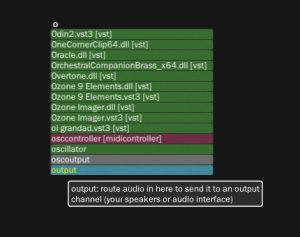
As noted above in the “DAW spectrum” discussion, Bespoke Synth doesn’t have modules that go as low-level as something like Bidule or Reaktor, but there is still quite a bit of room for experimentation, and you can bundle modules together into Prefabs or “effectchains.” Both of these are ways to group modules together for easy access later, with the main difference seeming to be that “effectchains” are strictly serial affairs, while Prefabs just load a set of modules inside a box that still gives you access to any and all inputs etc.
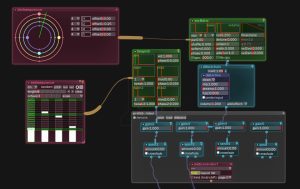
The modules on offer include a lot of the things one would expect, as well as some more interesting and inspiring stuff. Some of the standouts for me include feedback routing (via a module), some cool non-standard sequencing options, fun granular stuff, and a wide variety of modulation beyond the usual LFOs and such. There are also some excellent tools for working with samples, including a looper and the “samplecanvas,” which is a sort of multitrack sample sequencer thing.
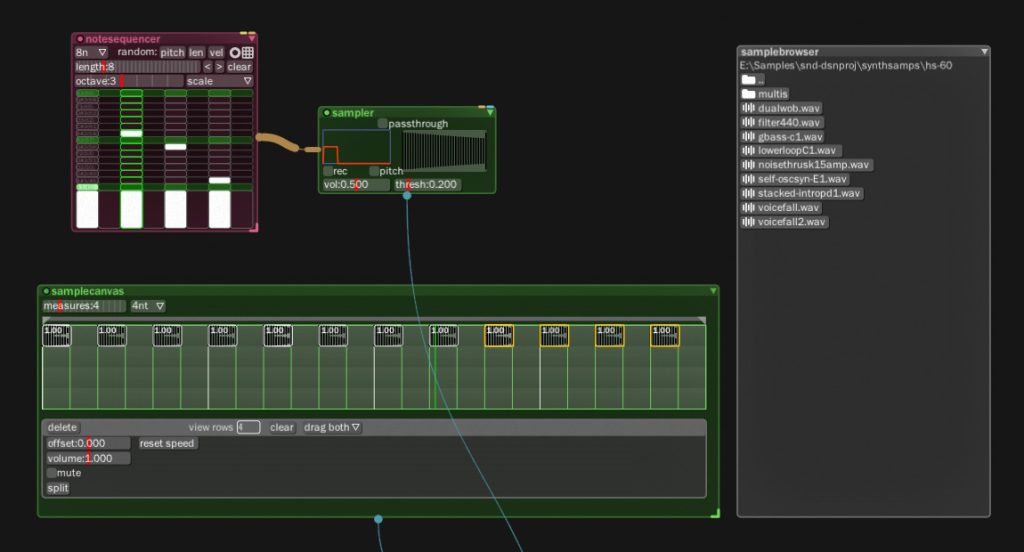
Plugin handling in Bespoke is generally good, with a couple of quirks. One of these is the way plugins are listed, which uses the same interface as the other modules. While this makes sense, it means that things get a bit clunky with a large number of plugins. The fact that you can access plugins through the “letter list” mentioned earlier is once again a huge help here, but since it only works with letters, plugins that have names starting with numbers are inaccessible with this method. The other issue is that there doesn’t seem to be a way to access plugin outputs beyond the first stereo pair.
A few other things worth mentioning here are the Python scripting/live-coding support, controller-focused modules like “gridkeyboard” and “vinylcontrol,” and the nice variety of Note Effect modules that provide a lot of fun ways to manipulate note data. Also, in addition to dedicated recording modules, Bespoke Synth automatically records the last 30 minutes of audio to an internal buffer of sorts, which can be written to a user-specified location using the “write audio” button on the main toolbar. This audio seems to be 16 bit only.
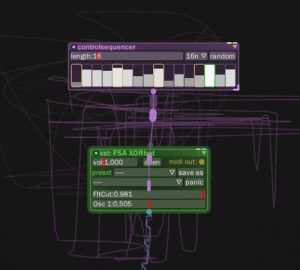
Modulation and Routing
Pretty much everything in Bespoke Synth can be modulated, including VST parameters, and even the BPM in the transport module. If it has a button, slider, or other control, that can be modulated in a number of ways using the included Modulators. Furthermore, every control can make use of a dedicated LFO (disabled by default), accessible with a right-click. The same type of LFO is available as a module like any other from the Other menu, in case you need more. These LFOs can be tempo-synced, and provide a good range of other options.
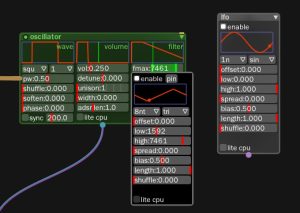
Routing is visually intuitive, dragging from a dot (output) on one module to another module. Shift-dragging on an audio output adds a send module (inserting it in the existing path if already connected), and doing the same to a control output adds a “macroslider” which provides a similar function for control signals. Note that these are the necessary modules for connecting an output to more than one destination, while a module can generally accept any number of inputs.
Final Thoughts
I’ve been using Bespoke Synth on a regular basis for some time now myself, so clearly I enjoy using it. I don’t see it becoming my main DAW, but that has mostly to do with personal preferences. Although I don’t think it would be everyone’s first choice, I would definitely recommend giving it a try, especially if you’re interested in the modular approach. I think it may be one of the more user-friendly of the modular-style DAWs.
Bespoke comes with some example patches, and you can also find some user-contributed patches on the patchstorage site (including some of my own).
